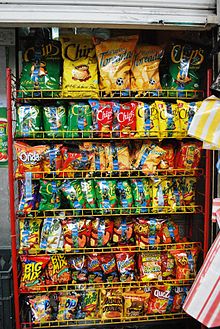- Convenience food
-
Convenience food, or tertiary processed food, is commercially prepared food designed for ease of consumption.[1] Products designated as convenience foods are often prepared food stuffs that can be sold as hot, ready-to-eat dishes; as room-temperature, shelf-stable products; or as refrigerated or frozen products that require minimal preparation (typically just heating).[2]
These products are often sold in portion controlled, single serve packaging designed for portability and "on-the-go" eating. Convenience food can include products such as candy; beverages such as soft drinks, juices and milk; fast food; nuts, fruits and vegetables in fresh or preserved states; processed meats and cheeses; and canned products such as soups and pasta dishes.
Contents
History
Modern convenience food saw its beginnings in the period that began after World War II in the United States. Many of these products had their origins in military developed foods designed for storage longevity and ease of preparation in the battle field. After the war, many commercial food companies were left with surplus manufacturing facilities. These companies developed new lines of canned and freeze dried foods that were designed for use in the home. Like many product introductions, not all were successful—convenience food staples such as fish sticks and canned peaches were counterbalanced by failures such as ham sticks and cheeseburgers-in-a-can.[3]
Criticisms
Critics have derided the increasing trend of convenience foods because of numerous issues. Several groups have cited the environmental harm of single serve packaging due to the increased usage of plastics that contributes to solid waste in landfills.[4][5]
Nutritional issues
According to a page on the website of the Cleveland Clinic: "Most convenience foods on the market today are laden with saturated fats, sodium and sugar and provide little to no nutritional value."[6]
Salt
Salt is an essential nutrient, but sodium, usually in the form of salt, has been linked with high blood pressure. A single serving of many convenience foods contains a significant portion of the recommended daily allowance of sodium. Manufacturers are concerned that if the taste of each product is not optimized by adding salt that it will not sell as well as competing products. Tests have shown that some popular packaged foods are dependent on significant amounts of salt for their palatability.[7]
Labeling, mitigation, and regulation
In response to the issues surrounding the healthfulness of convenience and restaurant foods, an initiative in the United States, spearheaded by first lady Michelle Obama and her "Let's Move" campaign, to reduce the unhealthy aspects of commercially produced food and fight childhood obesity, was unveiled by the White House in February 2010. Using her position as a bully pulpit, Mrs. Obama has pushed the industry to cut back on sugars and salts found in many convenience foods, encouraging self regulation over government intervention through laws and regulations.[8] Despite Mrs. Obama's stated preference on self-regulation, the Food and Drug Administration announced that it was looking into quantifying the guidelines into law while other groups and municipalities are seeking to add other preventative measures such as target taxes and levies onto these products.[9][10] In response to the attention, in April 2010 a coalition of sixteen manufactures all agreed to reduce salt levels in foods sold in the United States under a program based on a similar effort in the United Kingdom.[9] However, the initiative has met with resistance from some manufacturers, who claim that processed foods require the current high levels of salt to remain appetizing and to mask undesirable effects of food processing such as "warmed over flavor."[7] The coalition expanded its mission in May 2010 by announcing that it intends to reduce the amount of calories in foods. By introducing lower calorie foods, changing product recipes and reducing portion sizes, the coalition stated that it expected to reduce the caloric content of foods by more than 1.5 trillion calories in total by 2012.[10]
See also
References
- ^ Jean Anderson; Barbara Deskins (October 1995) (in EN). The Nutrition Bible (1st ed.). William Morrow & Co. ISBN 0688116191.
- ^ "Convenience Foods" (in en). Swiss Association for Nutrition. Health and Age Center. 2003-05-08. http://www.healthandage.com/Home/gid2=2434. Retrieved 2009-05-18.
- ^ Shapiro, Laura (March 29, 2005). Something from the Oven: Reinventing Dinner in 1950s America. New York: Penguin. ISBN 014303491X.
- ^ "Talking about waste prevention". Waste Watch UK. http://www.wastewatch.org.uk/page/4819/About-Us/Our-views/Talking-about-waste-prevention. Retrieved 2009-07-14.
- ^ "Food packaging waste a concern". Reuters. 2008-02-14. http://www.scientistlive.com/European-Food-Scientist/Packaging/Food_packaging_waste_a_concern/19764/. Retrieved 2009-07-14. "Wasteful food packaging is among the fastest-growing environmental concerns for shoppers worldwide with New Zealanders most willing to cut back, a poll showed on Thursday."
- ^ Melissa Stevens, MS, RD, LD. "Convenience Foods: A quick and healthy guide for those on the go" (in En). Cleveland Clinic. http://my.clevelandclinic.org/heart/prevention/nutrition/conveniencefoods.aspx. Retrieved 2009-05-18.
- ^ a b Michael Moss (29 May 2010). "The hard sell on salt". The New York Times. http://www.nytimes.com/2010/05/30/health/30salt.html.
- ^ Sweet, Lynn (11 May 2010). "Michelle Obama Unveils Anti-Childhood Obesity Action Plan". Politics Daily. http://www.politicsdaily.com/2010/05/11/michelle-obama-unveils-anti-childhood-obesity-action-plan/. Retrieved 29 May 2010.
- ^ a b "16 Food Companies Agree to Reduce Salt". CBS News. Associated Press. 26 April 2010. http://www.cbsnews.com/stories/2010/04/26/health/main6434928.shtml. Retrieved 29 May 2010.
- ^ a b Jalonick, Mary Clare (17 May 2010). "Food companies agree to remove 15 trillion calories from foods to reduce childhood obesity". Business News. Associated Pres. http://blog.taragana.com/business/2010/05/17/food-companies-agree-to-remove-15-trillion-calories-from-foods-to-reduce-childhood-obesity-61817/. Retrieved 29 May 2010.
External links
Categories:- Food and drink terminology
- Convenience foods
Wikimedia Foundation. 2010.


